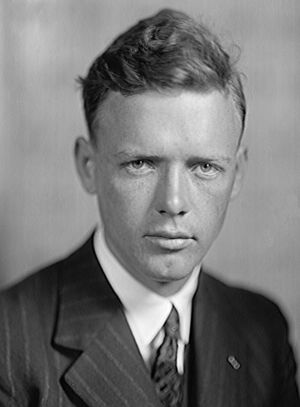Charles Lindbergh (nonfiction)
Charles Augustus Lindbergh (February 4, 1902 – August 26, 1974), nicknamed Slim, Lucky Lindy, and The Lone Eagle, was an American aviator, military officer, author, inventor, explorer, and environmental activist.
From an early age, Lindbergh had exhibited an interest in the mechanics of motorized transportation, including his family's Saxon Six automobile, and later his Excelsior motorbike. By the time he started college as a mechanical engineering student, he had also become fascinated with flying, though he "had never been close enough to a plane to touch it." After quitting college in February 1922, Lindbergh enrolled at the Nebraska Aircraft Corporation's flying school in Lincoln and flew for the first time on April 9, as a passenger in a two-seat Lincoln Standard "Tourabout" biplane trainer piloted by Otto Timm.
On April 13, 1926, Lindbergh executed the Post Office Department's Oath of Mail Messengers, and two days later he opened service on the newly designated 278-mile (447 km) Contract Air Mail Route #2 (CAM-2) to provide service between St. Louis and Chicago (Maywood Field) with two intermediate stops in Springfield and Peoria, Illinois.
At age 25 in 1927, he went from obscurity as a U.S. Air Mail pilot to instantaneous world fame by making his Orteig Prize–winning nonstop flight from Long Island, New York, to Paris. He covered the 33 1⁄2-hour, 3,600 statute miles (5,800 km) alone in a single-engine purpose-built Ryan monoplane, Spirit of St. Louis. This was the first solo transatlantic flight and the first non-stop flight between North America and mainland Europe. Lindbergh was an officer in the U.S. Army Air Corps Reserve, and he received the United States' highest military decoration, the Medal of Honor, for the feat.
His achievement spurred interest in both commercial aviation and air mail, and Lindbergh himself devoted much time and effort to promoting such activity.
Lindbergh's historic flight and instantaneous world fame led to tragedy. In March 1932, his infant son, Charles Jr., was kidnapped and murdered in what American media called the "Crime of the Century" and described by H. L. Mencken as "the biggest story since the resurrection." The case prompted the United States Congress to upgrade kidnapping from a state crime to a federal crime once the kidnapper had crossed state lines with his victim. By late 1935 the hysteria surrounding the case had driven the Lindbergh family into voluntary exile in Europe, from which they returned in 1939.
Before the United States formally entered World War II, some people accused Lindbergh of being a fascist sympathizer. An advocate of non-interventionism he supported the antiwar America First Committee, which opposed American aid to Britain in its war against Germany, and resigned his commission in the United States Army Air Forces in 1941 after President Franklin Roosevelt publicly rebuked him for his views. Nevertheless, he publicly supported the U.S. war effort after the Japanese attack on Pearl Harbor and flew fifty combat missions in the Pacific Theater of World War II as a civilian consultant, though Roosevelt refused to reinstate his Air Corps colonel's commission.
In his later years, Lindbergh became a prolific prize-winning author, international explorer, inventor, and environmentalist.
Lindbergh and his wife Anne Morrow Lindbergh were the parents of six children. In 2003 (two years after the death of his wife) it was revealed that, beginning in 1957, he had engaged in covert sexual affairs with three European women, with whom Lindbergh fathered seven more children, none of whom learned of his true identity until a decade after his death in 1974.
In the News
Fiction cross-reference
Nonfiction cross-reference
External links:
- Charles Lindbergh @ Wikipedia
